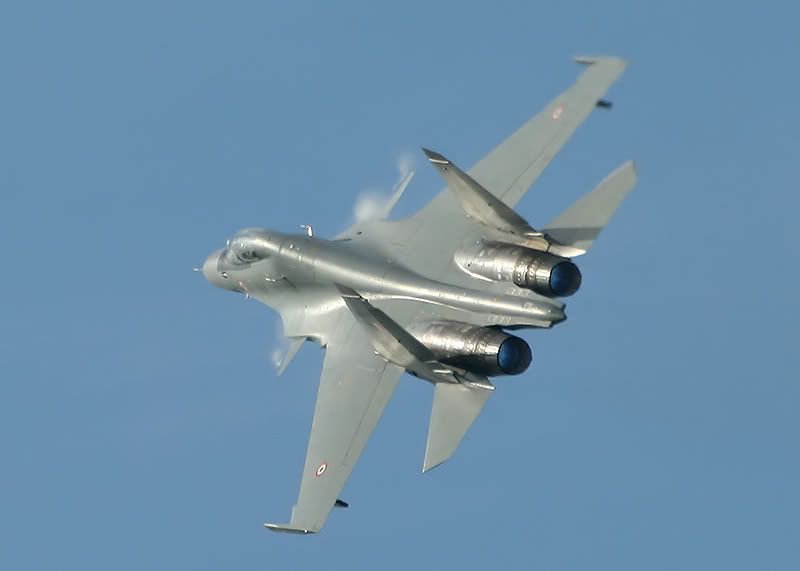Exercise Indradhanush (Rainbow) '07 @ RAF Waddington, UK
Here is an analytic comparison from Ausairpower between the SU-30s and the F-18series and the JSF.There are some excellent charts/maps in the site.http://www.ausairpower.net/APA-Flanker.html
Su-30 vs RAAF Alternatives
Many visitors will be asking the obvious question of how the Sukhois stack up against the F/A-18A HUG, the JSF panacea and recently proposed interim fighters such as the F/A-18E/F.
Against all three types the Su-30 derivatives, especially with later engine subtypes, will always have a significant kinematic advantage - there is no substitute for thrust in the kinematic performance game. There is another factor to consider here, which is the superlative 10 tonnes of internal drag free fuel the Sukhoi carries. When not operating at extended combat radii, the Sukhoi driver has more fuel to convert into energy, and that energy can nearly always be used to an advantage.
With mutually competitive WVR missiles and Helmet Mounted Sights/Displays for close-in combat, all three types will live or die in a close in engagement with an advanced Su-30MK variant by pilot ability and good or bad luck. The Sukhoi combines high alpha manoeuvre capabilities with excellent thrust/weight performance, and is apt to have an energy advantage entering and prosecuting a close in fight. A JSF driver opting to engage a thrust vectoring late model Su-30MK in a knife fight may not survive to speak of the experience, unless the Sukhoi driver is unable to exploit his advantage properly.
In close in air combat terms the JSF qualifies as 'double inferior' against the later model Sukhois, since the Sukhois have an advantage in both thrust/weight ratio and in wing loading (interested visitors refer R.L. Shaw's Fighter Combat), and with its canard and thrust vectoring capability will generally be able to gain a firing solution quicker. Because the JSF is designed within the kinematic performance class of the F/A-18 and F-16, it is right in the middle of the performance envelope of aircraft the Sukhoi was designed to kill.
This chart compares some cardinal design parameters for the Su-30MK series, the JSF and the F/A-18 family, using manufacturer's data. The effective wing loading of the Su-30 is better than depicted, since the aircraft's configuration delivers a considerable amount of body lift. While in the near term the AESAs in the JSF and F/A-18E/F will be competitive, in the longer term the retrofit of AESA technology in the N011M series radar will see the advantage in power aperture go to the Sukhoi - both the JSF and F/A-18E/F are aperture size and cooling capacity limited in growing AESA performance (Author).
In Beyond Visual Range (BVR) combat, the Sukhoi will again have a kinematic advantage, which may be exploitable at the bounds of engagement radii, as the Sukhoi can gain separation in and out of the missile envelope of the F/A-18's and JSF faster - it has the extra thrust and combat fuel to play kinematic games both smaller fighters cannot.
The BVR game is however dominated by sensor capabilities, both onboard and offboard the fighters, and long range missile capabilities. The F/A-18A HUG is wholly outclassed by an Su-30MK with an N011M phased array and R-77M ramjet missile. A late model F/A-18E with minimal external stores and the APG-79 AESA fares much better due to its radar signature reduction measures and better radar power-aperture performance, but with external stores its margin of survivability is eroded and it is likely to fall well within the engagement envelope of the Sukhoi and also come to grief (refer radar/missile plot). A post 2010 AESA equipped Sukhoi could almost certainly take on the F/A-18E with confidence as it will have much better power-aperture capability in the radar, enough to offset the radar signature reduction measures in the F/A-18E/F, with an advanced IRST to supplement radar data.
What happens when the existing OLS-27/30/31 series IRST is replaced with a newer longwave Focal Plane Array device - such as a single chip QWIP device? The result will be a capability to engage opposing aircraft under clear sky conditions regardless of RCS reduction measures. While the supercruising F/A-22A can defeat such techniques by kinematics alone, fighters in the teen series performance envelope will have to contend with BVR shots using the R-27ET, R-77, R-77T and R-77M cued by the thermal imaging search and track set. Similar issues arise with the deployment of modern ESM receivers on the Su-30MK, analogous to a number of existing Western systems. The Su-30MK series can then launch long range BVR missiles such as the R-27ET, R-77T with infrared seekers, or the R-27EP and R-77P with passive radio-frequency anti-radiation seekers. If cued by such sensors or offboard sources, these weapons will permit the Su-30MK to engage the JSF despite the JSF's good forward sector radar stealth performance (Author).
A clean JSF will have the advantage of a very low X-band radar signature in the forward quarter which will significantly degrade the Sukhoi's otherwise overwhelming radar power-aperture advantage over other types. However, the JSF is not designed to be a hot supersonic performer and like the F/A-18s will need to generously use afterburner to effect an intercept against a rapidly penetrating Sukhoi.
This exposes the JSF to detection and tracking by a newer technology IRST, and engagement by a long burn heatseeking or optically guided AAMs such as the R-27ET, R-77T or likely future variants with imaging seekers analogous to the AIM-9R and ASRAAM seekers. With the latter seekers an R-77/R-77M acquires many of the capabilities of the RAAF's superlative ASRAAM, especially jam resistance, but in a long range missile with datalink midcourse guidance. A new two-colour infrared seeker with 10.8 nautical mile acquisition range has been announced by the Arsenal infrared systems house, ostensibly for use on the R-77 series. Professionals might contemplate that these are not 1980s 36T series seekers.
Russia and the Ukraine have a competent infrared systems industry - e.g. Cyclone JSC recently described their QWIP single chip thermal imagers with 128x128 and 320x256 resolution, competitive against the latest EU technology and suitable for missile seekers and thermal imaging IRST detectors. Therefore an advanced derivative of the OLS-30/31 series with capabilities similar to the Eurofighter PIRATE thermal imaging IRST, but with better detection range, will be implementable with Russian hardware in the latter half of this decade given the current rate of evolution.
In the beam and aft sectors the JSF may be also quite vulnerable to an active or semiactive radar guided missile shot - its beam and aft sector radar signature reduction is much less refined than that in the forward sector. Another factor for the JSF is its radar emission - making it vulnerable to a long range shot with an anti-radiation seeker equipped R-27P, R-27EP, R-77P or when eventually deployed, ramjet R-77MP. While some Low Probability of Intercept (LPI) techniques may reduce vulnerability to anti-radiation missiles, radar modes for closing missile shots typically require high update rates and favour the anti-radiation seeker. Since the R-77/R-77M has a midcourse inertial package - Agat are developing FOG (fibre) gyro technology to avoid dependency on Western Ring Laser Gyro technology - transient loss of the JSF radar emission may not defeat the R-77P/R-77MP - or late model R-27P/EP.
Soviet and more recent Russian BVR doctrine has always emphasised firing pairs of missiles, one with heat-seeking guidance and one with radar guidance, to defeat countermeasures. With the option of active radar, heat-seeking and anti-radiation seekers, and by the end of the decade an imaging seeker, the result is a very lethal cocktail from a defensive countemeasures perspective - a defending fighter may only have datalink transmissions to provide warning and no indication of the seeker mix on the inbound missiles. With three of the four seeker technologies passive defeating such weapons is not trivial.
On publicly available data the JSF is likely to be detected and engaged by an N011M ESA equipped Su-30 inside the 10 to 20 nautical miles head on range envelope, unless the JSF can get the first shot off and successfully kill the Sukhoi. If the Sukhoi can close with the JSF, all bets are off on the JSF's ability to survive the close in engagement.
A view commonly heard in Canberra these days is that the use of the Wedgetail AEW&C to provide offboard targeting for the JSF will provide a decisive advantage over the Sukhois - 'Network Centric Warfare' will ostensibly offset all other deficiencies in the force structure and platform capabilities. This argument is clearly contingent upon a great many 'ifs' - if the Sukhois do not shoot very long range missiles at the Wedgetail to force it to shut down or indeed kill it, if the Wedgetail MESA is not jammed, if the JTIDS/MIDS or other datalinks to the fighters are not jammed, if the Sukhois are not carrying advanced IRSTs or X-band homing receivers, and if the Sukhois are not supported by HF or low VHF band radars.
If a JSF were deployed in 2005 with a supporting Wedgetail and existing Su-30 capabilities, then the argument probably holds most of the time. However, in a post 2010 environment it is most likely not going to hold up most of the time.
If Iraq could acquire smuggled Russian GPS jammers during a UN arms embargo, there is no guarantee that equipment like high power L-band jammers, advanced IRST, ESM receivers, long range ramjet powered anti-radiation missiles and low band radars will not proliferate into the region - the Kh-31P has been already been reported in use with the PLA-AF. Given the mistrust of the US and its allies we see in many regional players, be it the PRC or lesser nations, the odds are very good that the existing trend will persist and the most advanced Russian hardware, and indigenous equipment, will be widely used.
While this will not put a dent into the US Air Force's stealthy supercruising F-22A fleet, it is likely to make life very difficult for the USN with a planned force structure of F/A-18E/Fs and JSFs. If the RAAF opts for the JSF as its single type solution, and F/A-18F as an interim types, it is likely to experience similar grief.
In the long term the Russians will find a growing market for 'Counter-ISR' weapons - the 215 nautical mile R-172, 160 nautical mile R-37 and 60 nautical mile Kh-31 series. In any engagement against a Western air force, the first wave of Sukhois would shoot long range 'AWACS-killer' weapons such as the R-172, R-37, Kh-31 - or types as yet unknown - to either destroy the AEW&C/AWACS or force it to shut down and retreat - the 'AWACS-killer' theme is frequently seen in Russian marketing literature , statements and more recently promotoional video footage. The result is that forward defending CAPs have to then light up their radars to attempt to function autonomously - in turn making them vulnerable to detection by ESM and shots by anti-radiation missiles like the R-27EP or R-77P/MP. This Russian doctrine of a deluge of long range missiles is not new - it is a variation on their proven theme of attacking naval task forces with long range missiles. It is an evolutionary adaption to the growing dependency of Western air forces on large and vulnerable ISR platforms - the E-3 AWACS, RC-135V/W Rivet Joint, E-8 JSTARS, E-10 MC2A and of course the RAAF's new Wedgetail.
The reality is that of an evolving technological landscape in which advanced conventional weapons and supporting technologies proliferate often very rapidly. The rate of Su-30 uptake in the region is a good case study - any nation with the cash can acquire very quickly large numbers of top-tier combat aircraft often with the latest Western avionics and Russian weapons and sensors fitted.
Su-30 vs RAAF Alternatives
Many visitors will be asking the obvious question of how the Sukhois stack up against the F/A-18A HUG, the JSF panacea and recently proposed interim fighters such as the F/A-18E/F.
Against all three types the Su-30 derivatives, especially with later engine subtypes, will always have a significant kinematic advantage - there is no substitute for thrust in the kinematic performance game. There is another factor to consider here, which is the superlative 10 tonnes of internal drag free fuel the Sukhoi carries. When not operating at extended combat radii, the Sukhoi driver has more fuel to convert into energy, and that energy can nearly always be used to an advantage.
With mutually competitive WVR missiles and Helmet Mounted Sights/Displays for close-in combat, all three types will live or die in a close in engagement with an advanced Su-30MK variant by pilot ability and good or bad luck. The Sukhoi combines high alpha manoeuvre capabilities with excellent thrust/weight performance, and is apt to have an energy advantage entering and prosecuting a close in fight. A JSF driver opting to engage a thrust vectoring late model Su-30MK in a knife fight may not survive to speak of the experience, unless the Sukhoi driver is unable to exploit his advantage properly.
In close in air combat terms the JSF qualifies as 'double inferior' against the later model Sukhois, since the Sukhois have an advantage in both thrust/weight ratio and in wing loading (interested visitors refer R.L. Shaw's Fighter Combat), and with its canard and thrust vectoring capability will generally be able to gain a firing solution quicker. Because the JSF is designed within the kinematic performance class of the F/A-18 and F-16, it is right in the middle of the performance envelope of aircraft the Sukhoi was designed to kill.
This chart compares some cardinal design parameters for the Su-30MK series, the JSF and the F/A-18 family, using manufacturer's data. The effective wing loading of the Su-30 is better than depicted, since the aircraft's configuration delivers a considerable amount of body lift. While in the near term the AESAs in the JSF and F/A-18E/F will be competitive, in the longer term the retrofit of AESA technology in the N011M series radar will see the advantage in power aperture go to the Sukhoi - both the JSF and F/A-18E/F are aperture size and cooling capacity limited in growing AESA performance (Author).
In Beyond Visual Range (BVR) combat, the Sukhoi will again have a kinematic advantage, which may be exploitable at the bounds of engagement radii, as the Sukhoi can gain separation in and out of the missile envelope of the F/A-18's and JSF faster - it has the extra thrust and combat fuel to play kinematic games both smaller fighters cannot.
The BVR game is however dominated by sensor capabilities, both onboard and offboard the fighters, and long range missile capabilities. The F/A-18A HUG is wholly outclassed by an Su-30MK with an N011M phased array and R-77M ramjet missile. A late model F/A-18E with minimal external stores and the APG-79 AESA fares much better due to its radar signature reduction measures and better radar power-aperture performance, but with external stores its margin of survivability is eroded and it is likely to fall well within the engagement envelope of the Sukhoi and also come to grief (refer radar/missile plot). A post 2010 AESA equipped Sukhoi could almost certainly take on the F/A-18E with confidence as it will have much better power-aperture capability in the radar, enough to offset the radar signature reduction measures in the F/A-18E/F, with an advanced IRST to supplement radar data.
What happens when the existing OLS-27/30/31 series IRST is replaced with a newer longwave Focal Plane Array device - such as a single chip QWIP device? The result will be a capability to engage opposing aircraft under clear sky conditions regardless of RCS reduction measures. While the supercruising F/A-22A can defeat such techniques by kinematics alone, fighters in the teen series performance envelope will have to contend with BVR shots using the R-27ET, R-77, R-77T and R-77M cued by the thermal imaging search and track set. Similar issues arise with the deployment of modern ESM receivers on the Su-30MK, analogous to a number of existing Western systems. The Su-30MK series can then launch long range BVR missiles such as the R-27ET, R-77T with infrared seekers, or the R-27EP and R-77P with passive radio-frequency anti-radiation seekers. If cued by such sensors or offboard sources, these weapons will permit the Su-30MK to engage the JSF despite the JSF's good forward sector radar stealth performance (Author).
A clean JSF will have the advantage of a very low X-band radar signature in the forward quarter which will significantly degrade the Sukhoi's otherwise overwhelming radar power-aperture advantage over other types. However, the JSF is not designed to be a hot supersonic performer and like the F/A-18s will need to generously use afterburner to effect an intercept against a rapidly penetrating Sukhoi.
This exposes the JSF to detection and tracking by a newer technology IRST, and engagement by a long burn heatseeking or optically guided AAMs such as the R-27ET, R-77T or likely future variants with imaging seekers analogous to the AIM-9R and ASRAAM seekers. With the latter seekers an R-77/R-77M acquires many of the capabilities of the RAAF's superlative ASRAAM, especially jam resistance, but in a long range missile with datalink midcourse guidance. A new two-colour infrared seeker with 10.8 nautical mile acquisition range has been announced by the Arsenal infrared systems house, ostensibly for use on the R-77 series. Professionals might contemplate that these are not 1980s 36T series seekers.
Russia and the Ukraine have a competent infrared systems industry - e.g. Cyclone JSC recently described their QWIP single chip thermal imagers with 128x128 and 320x256 resolution, competitive against the latest EU technology and suitable for missile seekers and thermal imaging IRST detectors. Therefore an advanced derivative of the OLS-30/31 series with capabilities similar to the Eurofighter PIRATE thermal imaging IRST, but with better detection range, will be implementable with Russian hardware in the latter half of this decade given the current rate of evolution.
In the beam and aft sectors the JSF may be also quite vulnerable to an active or semiactive radar guided missile shot - its beam and aft sector radar signature reduction is much less refined than that in the forward sector. Another factor for the JSF is its radar emission - making it vulnerable to a long range shot with an anti-radiation seeker equipped R-27P, R-27EP, R-77P or when eventually deployed, ramjet R-77MP. While some Low Probability of Intercept (LPI) techniques may reduce vulnerability to anti-radiation missiles, radar modes for closing missile shots typically require high update rates and favour the anti-radiation seeker. Since the R-77/R-77M has a midcourse inertial package - Agat are developing FOG (fibre) gyro technology to avoid dependency on Western Ring Laser Gyro technology - transient loss of the JSF radar emission may not defeat the R-77P/R-77MP - or late model R-27P/EP.
Soviet and more recent Russian BVR doctrine has always emphasised firing pairs of missiles, one with heat-seeking guidance and one with radar guidance, to defeat countermeasures. With the option of active radar, heat-seeking and anti-radiation seekers, and by the end of the decade an imaging seeker, the result is a very lethal cocktail from a defensive countemeasures perspective - a defending fighter may only have datalink transmissions to provide warning and no indication of the seeker mix on the inbound missiles. With three of the four seeker technologies passive defeating such weapons is not trivial.
On publicly available data the JSF is likely to be detected and engaged by an N011M ESA equipped Su-30 inside the 10 to 20 nautical miles head on range envelope, unless the JSF can get the first shot off and successfully kill the Sukhoi. If the Sukhoi can close with the JSF, all bets are off on the JSF's ability to survive the close in engagement.
A view commonly heard in Canberra these days is that the use of the Wedgetail AEW&C to provide offboard targeting for the JSF will provide a decisive advantage over the Sukhois - 'Network Centric Warfare' will ostensibly offset all other deficiencies in the force structure and platform capabilities. This argument is clearly contingent upon a great many 'ifs' - if the Sukhois do not shoot very long range missiles at the Wedgetail to force it to shut down or indeed kill it, if the Wedgetail MESA is not jammed, if the JTIDS/MIDS or other datalinks to the fighters are not jammed, if the Sukhois are not carrying advanced IRSTs or X-band homing receivers, and if the Sukhois are not supported by HF or low VHF band radars.
If a JSF were deployed in 2005 with a supporting Wedgetail and existing Su-30 capabilities, then the argument probably holds most of the time. However, in a post 2010 environment it is most likely not going to hold up most of the time.
If Iraq could acquire smuggled Russian GPS jammers during a UN arms embargo, there is no guarantee that equipment like high power L-band jammers, advanced IRST, ESM receivers, long range ramjet powered anti-radiation missiles and low band radars will not proliferate into the region - the Kh-31P has been already been reported in use with the PLA-AF. Given the mistrust of the US and its allies we see in many regional players, be it the PRC or lesser nations, the odds are very good that the existing trend will persist and the most advanced Russian hardware, and indigenous equipment, will be widely used.
While this will not put a dent into the US Air Force's stealthy supercruising F-22A fleet, it is likely to make life very difficult for the USN with a planned force structure of F/A-18E/Fs and JSFs. If the RAAF opts for the JSF as its single type solution, and F/A-18F as an interim types, it is likely to experience similar grief.
In the long term the Russians will find a growing market for 'Counter-ISR' weapons - the 215 nautical mile R-172, 160 nautical mile R-37 and 60 nautical mile Kh-31 series. In any engagement against a Western air force, the first wave of Sukhois would shoot long range 'AWACS-killer' weapons such as the R-172, R-37, Kh-31 - or types as yet unknown - to either destroy the AEW&C/AWACS or force it to shut down and retreat - the 'AWACS-killer' theme is frequently seen in Russian marketing literature , statements and more recently promotoional video footage. The result is that forward defending CAPs have to then light up their radars to attempt to function autonomously - in turn making them vulnerable to detection by ESM and shots by anti-radiation missiles like the R-27EP or R-77P/MP. This Russian doctrine of a deluge of long range missiles is not new - it is a variation on their proven theme of attacking naval task forces with long range missiles. It is an evolutionary adaption to the growing dependency of Western air forces on large and vulnerable ISR platforms - the E-3 AWACS, RC-135V/W Rivet Joint, E-8 JSTARS, E-10 MC2A and of course the RAAF's new Wedgetail.
The reality is that of an evolving technological landscape in which advanced conventional weapons and supporting technologies proliferate often very rapidly. The rate of Su-30 uptake in the region is a good case study - any nation with the cash can acquire very quickly large numbers of top-tier combat aircraft often with the latest Western avionics and Russian weapons and sensors fitted.
Anecdotal, upon my brother and I plying a senior officer we are close to with Single Malts. He said that in spite of the conditions being weighted against us, 60-40 showed our boys did well. Only BVR counts, and the AdlA had a lot of experience and expertise, besides, in their own words, the RDI is equal to and RD-Y radar superior to that of the Su-30 in the k version.gauravjkale wrote:please confirm the source. cos even i have never heard of that ratio. I think the french had pitched their mirage 2000. and even SU-30Ks are more than a match for M-2Ks.parshu wrote:Purleez tell me what happened to the EFTvs MKI duels, particularly the BVR ones. I heard the French won 60-40 of the engagements in Garuda against the Su-30k. This EFT is the next gen from the M2K - RDY the AdlA flew. On the other hand, we were flying MKIs, not Ks. So please someone, let me know.
Anecdotal, upon my brother and I plying a senior officer we are close to with Single Malts. He said that in spite of the conditions being weighted against us, 60-40 showed our boys did well. Only BVR counts, and the AdlA had a lot of experience and expertise, besides, in their own words, the RDI is equal to and RD-Y radar superior to that of the Su-30 in the k version.gauravjkale wrote:please confirm the source. cos even i have never heard of that ratio. I think the french had pitched their mirage 2000. and even SU-30Ks are more than a match for M-2Ks.parshu wrote:Purleez tell me what happened to the EFTvs MKI duels, particularly the BVR ones. I heard the French won 60-40 of the engagements in Garuda against the Su-30k. This EFT is the next gen from the M2K - RDY the AdlA flew. On the other hand, we were flying MKIs, not Ks. So please someone, let me know.
RAF- IAF CHEFS SPICED INDRADHANUSH FLAVOUR
If ever the airmen on both sides - IAF and RAF, differed on tactics during the just-concluded ‘Exercise Indradhanush 2007’, at RAF Waddington, it never showed when the two sat together at the Mobile Catering Support Unit (MCSU) for their afternoon meals.
While their respective aircraft received fuel at the tarmac for their next flight, five RAF and two IAF chefs were fuelling nourishment for the aircrew and the ground crew at the MCSU. More popular in the RAF as the ‘field kitchen’, the MCSU housed beneath three large canopied tents - a kitchen and two dining areas that remained the common meeting zone.
Relishing the modest, yet appeasing fares were nearly 250 airmen from both the air forces during lunch, and about 60-70 RAF personnel, their dinner. Both, the visiting Chief of Air Staff from India, Air Chief Marshal FH Major and the RAF Commander-in-Chief Air Command, Air Chief Marshal Sir Clive Loader also had an opportunity to taste the mixed fare of English continental menu and a few Indian dish together, during their visit on the last day of the exercise.
The five RAF chefs - Sergent Edwards, Corporals Fletcher, Alps and SACs Harrison and Kneller are all trained from RAF Houlton. But they had no clue to any of the Indian dishes that they cooked prior to the exercise. “Whatever little we tried (cooking) was picked up from some Indian recipe books,â€
If ever the airmen on both sides - IAF and RAF, differed on tactics during the just-concluded ‘Exercise Indradhanush 2007’, at RAF Waddington, it never showed when the two sat together at the Mobile Catering Support Unit (MCSU) for their afternoon meals.
While their respective aircraft received fuel at the tarmac for their next flight, five RAF and two IAF chefs were fuelling nourishment for the aircrew and the ground crew at the MCSU. More popular in the RAF as the ‘field kitchen’, the MCSU housed beneath three large canopied tents - a kitchen and two dining areas that remained the common meeting zone.
Relishing the modest, yet appeasing fares were nearly 250 airmen from both the air forces during lunch, and about 60-70 RAF personnel, their dinner. Both, the visiting Chief of Air Staff from India, Air Chief Marshal FH Major and the RAF Commander-in-Chief Air Command, Air Chief Marshal Sir Clive Loader also had an opportunity to taste the mixed fare of English continental menu and a few Indian dish together, during their visit on the last day of the exercise.
The five RAF chefs - Sergent Edwards, Corporals Fletcher, Alps and SACs Harrison and Kneller are all trained from RAF Houlton. But they had no clue to any of the Indian dishes that they cooked prior to the exercise. “Whatever little we tried (cooking) was picked up from some Indian recipe books,â€
CONTROLLING AERIAL COMBATS – AN UNSEEN SAGA
Even as the Su-30 MKIs, F3 Tornadoes and Eurofighter Typhoons of the Indian Air Force (IAF) and the Royal Air Force (RAF), battle it out in the sky during – Indradhanush 2007, elsewhere discreetly and unseen at the ‘Control and Reporting Centre’ (CRC) of RAF Scampton, a team of ‘fighter controllers’ (FC) from both Air Forces remain closeted and deeply engrossed on computer screens, albeit keeping a close watch on the proceedings.
Of a marked significance during the exercise is the role of FCs accompanying the IAF contingent. In an airspace that is normally bereft of any liberties, fighter pilots invariably depend on them for manouevring tactically when engaging enemy targets in the air. “It is a team work,â€
Even as the Su-30 MKIs, F3 Tornadoes and Eurofighter Typhoons of the Indian Air Force (IAF) and the Royal Air Force (RAF), battle it out in the sky during – Indradhanush 2007, elsewhere discreetly and unseen at the ‘Control and Reporting Centre’ (CRC) of RAF Scampton, a team of ‘fighter controllers’ (FC) from both Air Forces remain closeted and deeply engrossed on computer screens, albeit keeping a close watch on the proceedings.
Of a marked significance during the exercise is the role of FCs accompanying the IAF contingent. In an airspace that is normally bereft of any liberties, fighter pilots invariably depend on them for manouevring tactically when engaging enemy targets in the air. “It is a team work,â€
RIAT continued :
Image Credits : I 8 Spotters

http://www.ukarimages.com/is.php?i=1906 ... GP8656.JPG
Image credits : i love aircraft
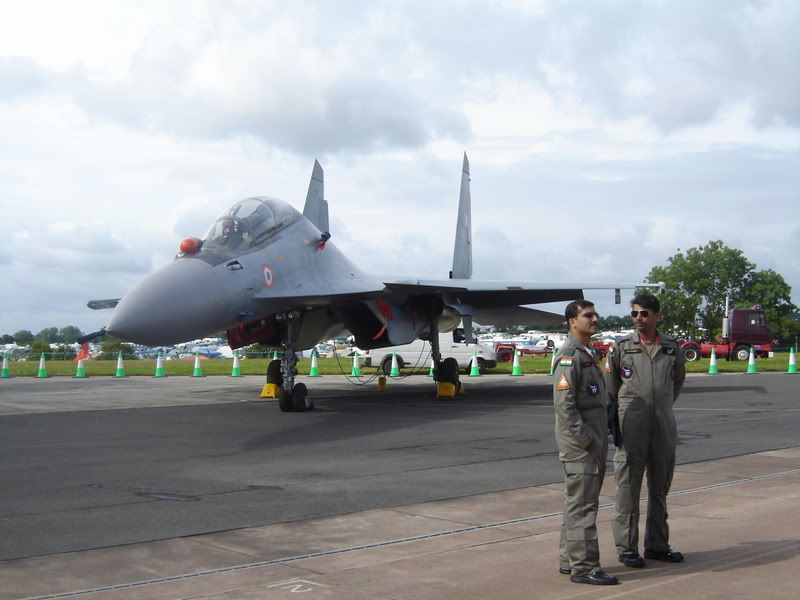
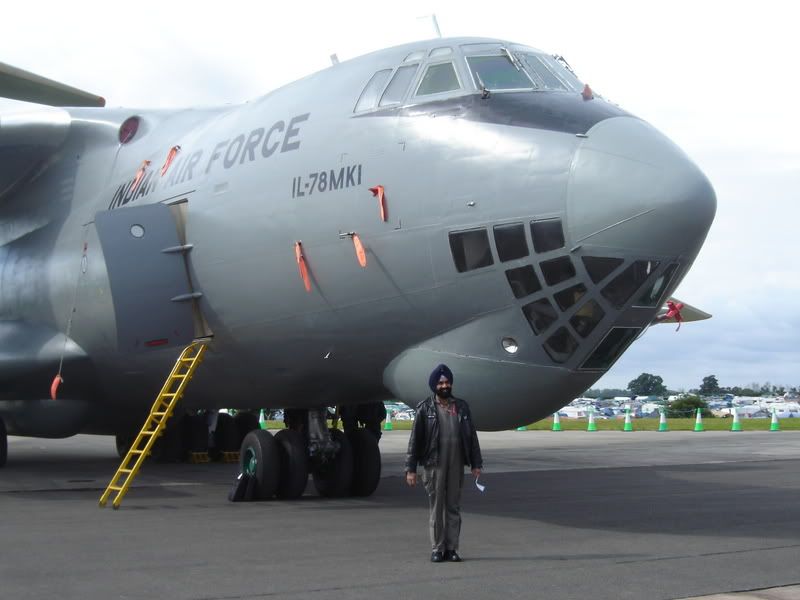
Indian AF pilots checking out Gripen
Image Credits : UKTopgun

Image Credits : I 8 Spotters
http://www.ukarimages.com/is.php?i=1906 ... GP8656.JPG
Image credits : i love aircraft


Indian AF pilots checking out Gripen
Image Credits : UKTopgun

Rakesh,
Requesting some thread clean up here please !
Added later after thread clean up
Rakman,
Thanks for the clean up. I can vouch for the fact that mahendra isn't what you suspect him to be, he is among one of the prolific and admired contributors to Stratforum's P-e-N-I-S thread.

Requesting some thread clean up here please !
Added later after thread clean up
Rakman,
Thanks for the clean up. I can vouch for the fact that mahendra isn't what you suspect him to be, he is among one of the prolific and admired contributors to Stratforum's P-e-N-I-S thread.
Last edited by JaiS on 22 Jul 2007 07:39, edited 1 time in total.
Video
Got this off a different forum.
A video DVD of MKIs and Ex. Indradhanush are available. The DVD will be 50 min. long and will include MKI flyout at RIAT. Anyone who is interested, can contact pheonix 47
A nice 5 minute preview of the DVD, which has nice footage of MKI takeoff and flypast can be seen below.
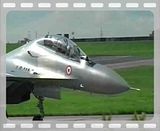
Photos :
Some more photos from RIAT, this time from StereoImage
Flanker Takeoff
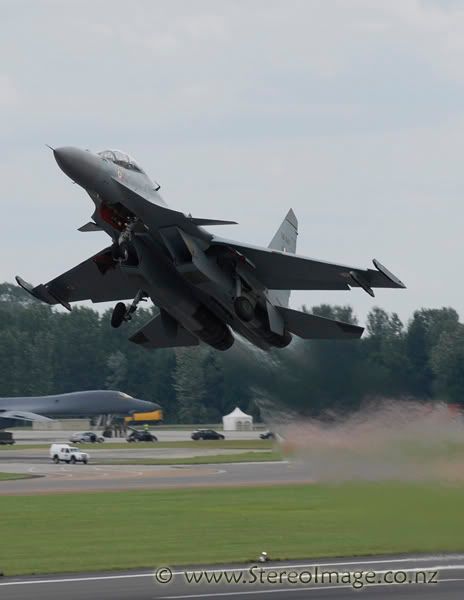
IL-76
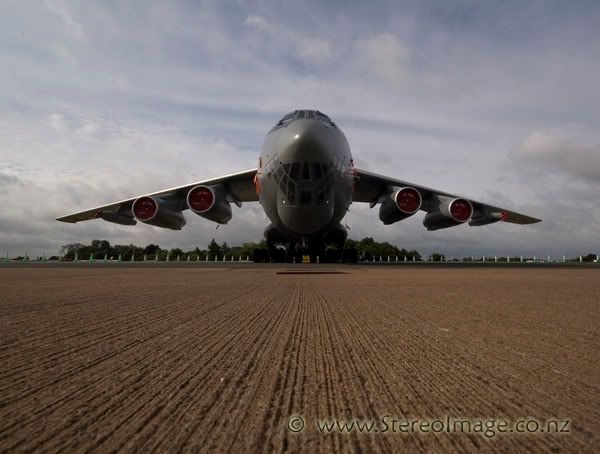
Flanker and a beer can !
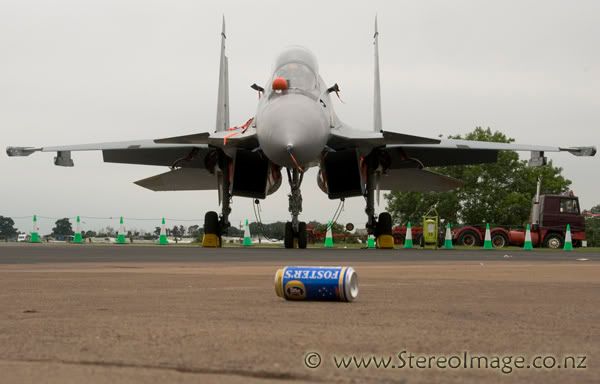
Image Credits : Vicky Clare
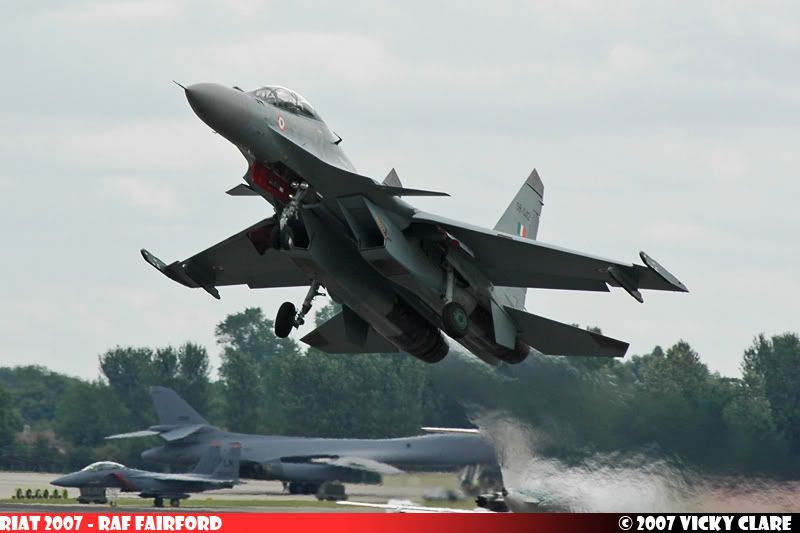
Got this off a different forum.
A video DVD of MKIs and Ex. Indradhanush are available. The DVD will be 50 min. long and will include MKI flyout at RIAT. Anyone who is interested, can contact pheonix 47
A nice 5 minute preview of the DVD, which has nice footage of MKI takeoff and flypast can be seen below.

Photos :
Some more photos from RIAT, this time from StereoImage
Flanker Takeoff

IL-76

Flanker and a beer can !

Image Credits : Vicky Clare

Last edited by JaiS on 22 Jul 2007 10:39, edited 1 time in total.
Seeing the Rambha flying with the RAF Tornado was a pleasant sight. Good video.JaiS wrote:Got this off a different forum. A video DVD of MKIs and Ex. Indradhanush are available. The DVD will be 50 min. long and will include MKI flyout at RIAT. Anyone who is interested, can contact pheonix 47
Some more images from Ex. Indra Dhanush.
Image Credits : mild-03



Image Credits : elderforest


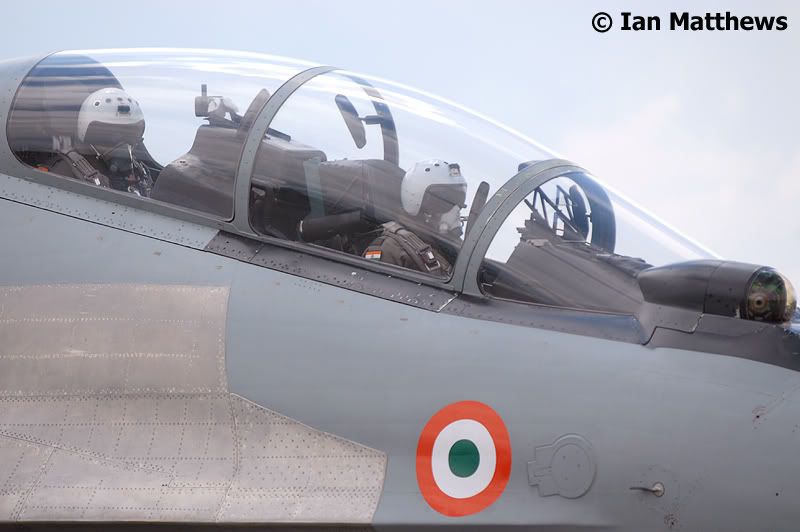
Note the Flanker in the background
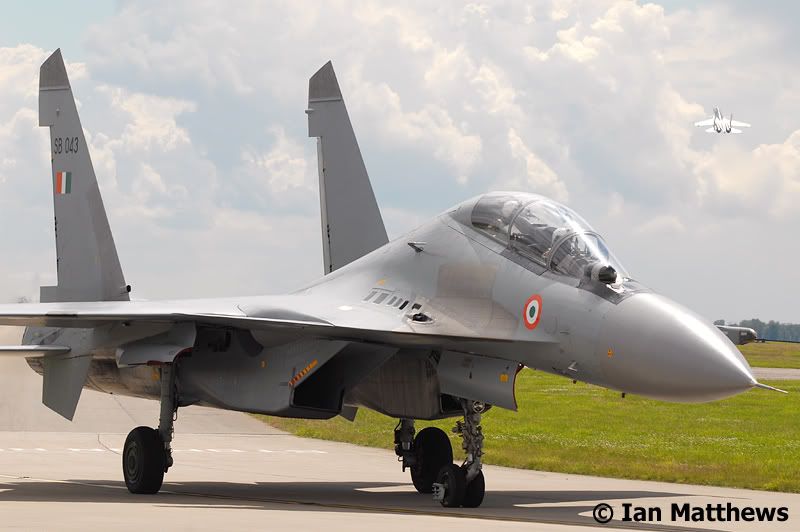
Image Credits : bigcrow

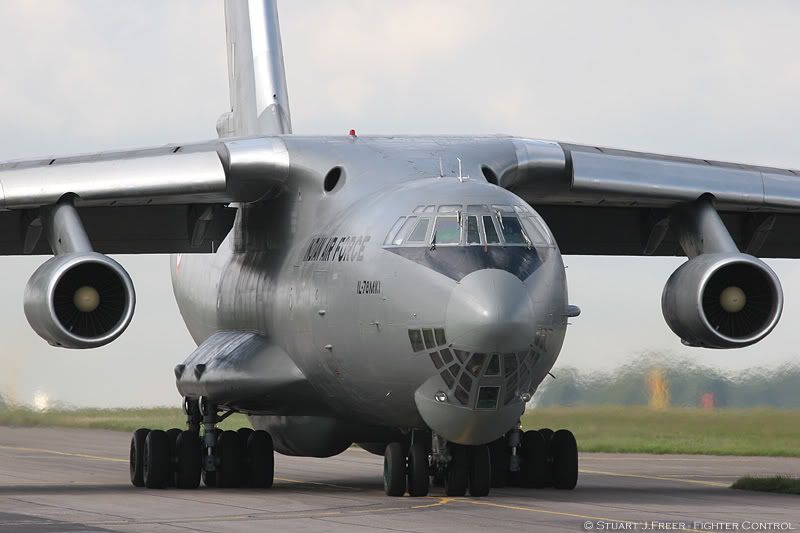
Image Credits : mild-03



Image Credits : elderforest



Note the Flanker in the background

Image Credits : bigcrow


Rambha Ho!
What a beautiful clip. Love the way the Rambha contracts her exhausts before the t/o run. Guess the smallest aperture maximizes newton's 3rd law.
[quote="JaiS"]Video
Got this off a different forum.
A video DVD of MKIs and Ex. Indradhanush are available. The DVD will be 50 min. long and will include MKI flyout at RIAT. Anyone who is interested, can contact [url=http://forums.airshows.co.uk/cgi-bin/uk ... oard.cgi?s
[quote="JaiS"]Video
Got this off a different forum.
A video DVD of MKIs and Ex. Indradhanush are available. The DVD will be 50 min. long and will include MKI flyout at RIAT. Anyone who is interested, can contact [url=http://forums.airshows.co.uk/cgi-bin/uk ... oard.cgi?s
Re: Rambha Ho!
Not contract - they expand when the afterburners kick in.parshu wrote:What a beautiful clip. Love the way the Rambha contracts her exhausts before the t/o run. Guess the smallest aperture maximizes newton's 3rd law.
Convergent divergent exhaust nozzles. w/o afterburner they converge to maximize thrust. With afterburner they diverge. Usually convergent nozzles indicate subsonic flight and divergent supersonic flight. They are controlled by the FADEC unit that is linked to the flight computer.
Wanted to know something – most aircraft have redundant flight controls - however what happens incase of total control failure? Most planes retain a manual hydraulic channel, but most modern airframes being inherently unstable, will the pilot be able to fly back home? Were there any actual cases of total flight computer failure?
Wanted to know something – most aircraft have redundant flight controls - however what happens incase of total control failure? Most planes retain a manual hydraulic channel, but most modern airframes being inherently unstable, will the pilot be able to fly back home? Were there any actual cases of total flight computer failure?
I believe the convergence and divergence is a function of the mass of air that is required to flow through - but I would wait for wiser and more informed opinion on this.tsarkar wrote:Convergent divergent exhaust nozzles. w/o afterburner they converge to maximize thrust. With afterburner they diverge.
yes the Cd coefficient of discharge is greater than 1 if remember correctly from my fluid mechanics classshiv wrote:I believe the convergence and divergence is a function of the mass of air that is required to flow through - but I would wait for wiser and more informed opinion on this.tsarkar wrote:Convergent divergent exhaust nozzles. w/o afterburner they converge to maximize thrust. With afterburner they diverge.
It is a function of both exhaust flow velocity and ambient pressure.shiv wrote:I believe the convergence and divergence is a function of the mass of air that is required to flow through - but I would wait for wiser and more informed opinion on this.tsarkar wrote:Convergent divergent exhaust nozzles. w/o afterburner they converge to maximize thrust. With afterburner they diverge.
For subsonic flows, you want a convergent nozzle to accelerate the flow, whereas for supersonic flows you want a divergent one. To accelerate a subsonic flow to supersonic, you use a convergent geometry to accelerate upto mach 1 (at the throat) after which you use a divergent geometry to accelerate the flow even further into supersonic regime.
However, if the flow is under-expanded or over-expanded (in terms of pressure) when compared to ambient pressure at altitude, there will be some thrust losses. Thus, the nozzle geometry will have to be configured to take that into consideration as well, so there is some amount of trade-off over there.
Re: Rambha Ho!
Right of course they should, perhaps that was the initial part of the movement only, thanks for clarifyingshiv wrote:Not contract - they expand when the afterburners kick in.parshu wrote:What a beautiful clip. Love the way the Rambha contracts her exhausts before the t/o run. Guess the smallest aperture maximizes newton's 3rd law.
For subsonic flows, you want a convergent nozzle to accelerate the flow, whereas for supersonic flows you want a divergent one. To accelerate a subsonic flow to supersonic, you use a convergent geometry to accelerate upto mach 1 (at the throat) after which you use a divergent geometry to accelerate the flow even further into supersonic regime.
I guess that's why the nozzles first converged after the Rambha was in t/o position and then quickly expanded as the reheat kicked in. Of course the computer would probably have controlled it all, squeezing max efficiency out while the pilot just moved up the throttle. Really interesting and informed posts above.
I guess that's why the nozzles first converged after the Rambha was in t/o position and then quickly expanded as the reheat kicked in. Of course the computer would probably have controlled it all, squeezing max efficiency out while the pilot just moved up the throttle. Really interesting and informed posts above.
have no technical knowlegde of couse, but i understand an inherently unstable platform is impossible to fly because it demands too much continuous adjustment. I think FBW is called quad redundant flight control, and my guess is they can fail four times ( or is it three) before the pilot presses Ctrl E.tsarkar wrote:Convergent divergent exhaust nozzles. w/o afterburner they converge to maximize thrust. With afterburner they diverge. Usually convergent nozzles indicate subsonic flight and divergent supersonic flight. They are controlled by the FADEC unit that is linked to the flight computer.
Wanted to know something – most aircraft have redundant flight controls - however what happens incase of total control failure? Most planes retain a manual hydraulic channel, but most modern airframes being inherently unstable, will the pilot be able to fly back home? Were there any actual cases of total flight computer failure?
The variable area exhaust nozzles or converging divergent nozzle as has been . called here are incorporated in combat aircraft to maximize the iso entropic efficiency's of the expanding exhaust gases by varying the the throat area with a series of circumferentially arranged flaps to suit various flight conditions like take off ,cruise,combat and landing.In thrust vectoring aircraft like sukhois they also perform the additional duty of vectoring the thrust in flight by positioning the circumferential flaps like the standard control flaps to generate additional control moment reflected in the remarkable super agility of the flankers.
Essentially the flight computer decides on the area of the throat to maximize
not thrust but thermodynamic efficiency so that max work is available under a particular flight configuration .That is why the nozzles contract at the start of the take off roll and open up like a flowers petals as the aircraft accelerates to take of speed as more air mass flows in the variable area exhaust nozzle maintains the optimum pressure ratio between the combustion chamber and outside atmosphere. In pune the nozzles may start opening up after 3-5 seconds in Leh maybe after 5-9 seconds -just a guess
Essentially the flight computer decides on the area of the throat to maximize
not thrust but thermodynamic efficiency so that max work is available under a particular flight configuration .That is why the nozzles contract at the start of the take off roll and open up like a flowers petals as the aircraft accelerates to take of speed as more air mass flows in the variable area exhaust nozzle maintains the optimum pressure ratio between the combustion chamber and outside atmosphere. In pune the nozzles may start opening up after 3-5 seconds in Leh maybe after 5-9 seconds -just a guess
Interesting points - but every time I have watched take-offs - the nozzles have opened up along with the afterburner kicking in - just before the aircraft begins to roll. And this is true for MiG 21s and 23s too - without any computer control.
Also "quadruple redundant" system does not mean 4 failures are allowed. It only means that 4 separate inputs control the surfaces and the failure of any one or more will not result in total failure.
I believe that fly by wire aircraft either retain some rudimentary conventional control, or the flight surfaces revert to a pre-set neutral position in case of total failure giving some semblance of stability and control.
However, loss of control was apparently inherently more likely with conventional rods/cables because of their size and position. For FBW - wires can be situated/ protected better and are less likely to sustain battle damage. Total loss of control could only probably occur with a catastrophic failure of power and back up power, or with serious damage (tailplane/wing blown off) which would essentially render most a/c unflyable anyway.
Also "quadruple redundant" system does not mean 4 failures are allowed. It only means that 4 separate inputs control the surfaces and the failure of any one or more will not result in total failure.
I believe that fly by wire aircraft either retain some rudimentary conventional control, or the flight surfaces revert to a pre-set neutral position in case of total failure giving some semblance of stability and control.
However, loss of control was apparently inherently more likely with conventional rods/cables because of their size and position. For FBW - wires can be situated/ protected better and are less likely to sustain battle damage. Total loss of control could only probably occur with a catastrophic failure of power and back up power, or with serious damage (tailplane/wing blown off) which would essentially render most a/c unflyable anyway.
-quite correct as the after burner kicks in the volume of exhaust gas increases by about 30% suddenly and the flaps open up to reduce pressure drop across the throat so that back pressure do not build up on the combustion chamber and more importantly on turbine exhaustInteresting points - but every time I have watched take-offs - the nozzles have opened up along with the afterburner kicking in - just before the aircraft begins to roll. And this is true for MiG 21s and 23s too - without any computer control.
TV Nozzles and our boys
Though I admire the Russian engineering genius that has produced these beauties that the US and Europeans have been forced to copy/reinvent, , does anybody have any info on how the IAF's experince with the Thrust Vector nozzles of the Rambha's Lyulka's has been? have they been reliable?Have we developed new home-grown tactics at TACDE? Were the Sea harrier vs Mirage Dogfights in the Falklands, the only instance where I think TV has been used tactically in combat, bring any relevant learnings?I am sure it would have all made a difference at Waddington.
The US had tested thrust vectoring earlier than the Russians. (Does anyone remember the F-15 with canards and TVC exhausts? Maybe someone can post a picture).
The reason they decided not to proceed was –
1. The fighter loses its energy at the end of those maneuvers and for the time period it takes to regain energy, in a multi entity dogfight, they presented an easy target to other enemy planes in vicinity.
2. The degree of maintenance and the enhanced logistic effort required for TVC engines and decided to stick with control surfaces. The AL-100 TVC unit TBO 1/5th of the AL-31FP.
3. Those days their focus was on BVR.
The IAF uses Su-30 for air dominance and hence find this feature useful. IAF has the requisite infrastructure for supporting its hardware.
On the other hand, the IN, based on its Sea Harrier experience decided not to incorporate TVC in its MiG29K. Carrier space/personnel limitations will not enable the requisite maintenance footprint.
The limited # of IN carrier fighters will not be used to air dominance, rather defend the fleet against enemy targeting assets or force enemy strike assets to abort or launch before weapons envelope or edges of weapons envelope. In addition they will need only to keep a window open for a limited time for friendly strike package.
Even the RAF/RN discouraged the use of viffing on its Harriers as a SOP, other than training and combat situations, for similar reasons.
Another myth – RN Harriers never used viffing in Falklands. BAe probably circulated this myth to sell the Harrier to USMC, where it made a lot of money. Those days USMC used A4 for strike and F4 for cover and BAe proposed the Harrier to undertake both these roles.
There are books debunking this myth written by Ex RN pilots participating in the war – a book by one Commander Ward – and another by someone named Bowen - don’t recollect exactly the names – read many years ago. This information was also confirmed by IN pilots undergoing training in UK.
IAF too uses TVC for specific instances rather than SOP. I recollect IAF specifically declining to do those maneuvers during Aero India 2005 for maintenance/airframe life issues
The reason they decided not to proceed was –
1. The fighter loses its energy at the end of those maneuvers and for the time period it takes to regain energy, in a multi entity dogfight, they presented an easy target to other enemy planes in vicinity.
2. The degree of maintenance and the enhanced logistic effort required for TVC engines and decided to stick with control surfaces. The AL-100 TVC unit TBO 1/5th of the AL-31FP.
3. Those days their focus was on BVR.
The IAF uses Su-30 for air dominance and hence find this feature useful. IAF has the requisite infrastructure for supporting its hardware.
On the other hand, the IN, based on its Sea Harrier experience decided not to incorporate TVC in its MiG29K. Carrier space/personnel limitations will not enable the requisite maintenance footprint.
The limited # of IN carrier fighters will not be used to air dominance, rather defend the fleet against enemy targeting assets or force enemy strike assets to abort or launch before weapons envelope or edges of weapons envelope. In addition they will need only to keep a window open for a limited time for friendly strike package.
Even the RAF/RN discouraged the use of viffing on its Harriers as a SOP, other than training and combat situations, for similar reasons.
Another myth – RN Harriers never used viffing in Falklands. BAe probably circulated this myth to sell the Harrier to USMC, where it made a lot of money. Those days USMC used A4 for strike and F4 for cover and BAe proposed the Harrier to undertake both these roles.
There are books debunking this myth written by Ex RN pilots participating in the war – a book by one Commander Ward – and another by someone named Bowen - don’t recollect exactly the names – read many years ago. This information was also confirmed by IN pilots undergoing training in UK.
IAF too uses TVC for specific instances rather than SOP. I recollect IAF specifically declining to do those maneuvers during Aero India 2005 for maintenance/airframe life issues
Last edited by tsarkar on 30 Jul 2007 13:14, edited 1 time in total.
Rambha
I was delighted to find that name on this forum. Whoever thought it up, it is a delightful name evocative of the thrust-vectored dance in the heavens the Su-30 can do. I wont speculate on the thunder thigh engines' similarity to the eponymous actress' phisiognomy, but it adds to the spirit.tsarkar wrote:BTW why do all of you refer to the Su30 as Rambha? As my understanding goes, dont see any connection with Indra's apsara. Its neither an official name nor do the men use it.
Other than notable exceptions like Baaz and Vajra, officialdom has made a hash of naming our aircraft. Bahadur, Vikram and Tejas, for God's sake. How flat and unexciting. why not call them Suresh or Ajay?
Even the navy scores with Vikramaditya.
Like Mae West, if rambha catches on, I'll be happy, but knowing us we'll probably end up naming it something trite and cliched.
Last edited by parshu on 30 Jul 2007 13:34, edited 1 time in total.
Typhoon vs Rambha
Contacted a very, repeat very, Senior Officer yesterday. He said the only info he could share is what has been reported in the papers and the rest is all highly classified. He also said that the newspapers had got it all quite wrong though - basically its difficult to classify one fighter against the other in short excercises. The envelope is so big that for a realistic analysis, both aircraft would have to fly 300 or maybe more sorties together for any sort of real evaluation.
The Sukhoi, according to him, is the benchmark for the West as they still need to catch up with that aircraft's flying capability. Avionics, is a different cup of tea. I guess it's a no-brainer that that's where the West has an edge.
Cant dig up anymore guys. I think the stink after Cope Thunder has made Air Forces agree not to give out kill ratios
The Sukhoi, according to him, is the benchmark for the West as they still need to catch up with that aircraft's flying capability. Avionics, is a different cup of tea. I guess it's a no-brainer that that's where the West has an edge.
Cant dig up anymore guys. I think the stink after Cope Thunder has made Air Forces agree not to give out kill ratios
Re: TV Nozzles and our boys
parshu wrote:Though I admire the Russian engineering genius that has produced these beauties .......
You havent seen anything till you've seen the old Mig-23MF's (Rakshak) nozzle - no controls, free floating, takes the mean position dictated by inside and outside pressure - and delivers (or rather, delivered) a whopping 15% extra thrust!
Re: Typhoon vs Rambha
Well do you think when jets are being evaluated for purchase they have to fly 300 or more sorties for being selected as the winner ? Do you seriously think IAF will make MRCA bidders fly 300 sorties each to evaluate which one is the best ?parshu wrote: basically its difficult to classify one fighter against the other in short excercises. The envelope is so big that for a realistic analysis, both aircraft would have to fly 300 or maybe more sorties together for any sort of real evaluation.
Just a name for us BRFites. All in fun.tsarkar wrote:BTW why do all of you refer to the Su30 as Rambha? As my understanding goes, dont see any connection with Indra's apsara. Its neither an official name nor do the men use it.
I remember reading a news clip a while back, that the vanilla Su-30 is referred to as Romeo in the IAF. I am not sure how authentic that report was. It does not matter if Rambha is acceptable to the IAF, it is acceptable in BRF and that is all that matterskrishnan wrote:Whats in a name? I dont think rambha would be acceptable to IAF
